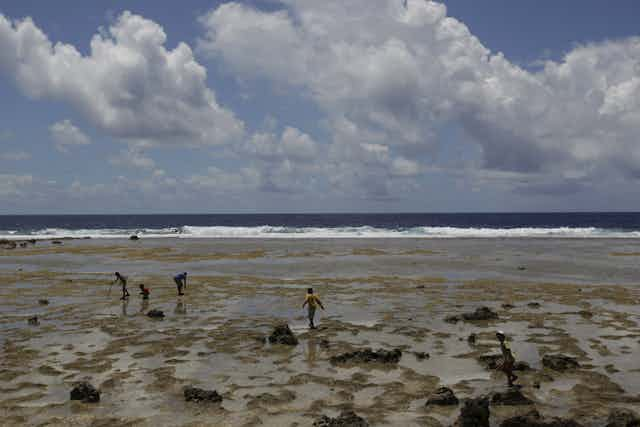News of the Nauruan government’s decision to turn its Australian-funded detention centre into an “open centre” started circulating among detainees on Sunday afternoon. Their immediate response was one of deep anxiety and foreboding.
A wave of fear swept through the women in the camp in particular. Several immediately turned to the thought of ending their lives as the only option.
Despite Immigration Minister Peter Dutton’s spin, the undeniable truth is that Nauru – whether inside or outside the confines of the detention camp – is a dangerous and soul-destroying place for asylum seekers and refugees. The move to turn the entire camp into an open centre just made it an even more deadly one.
Unsafe inside and outside the centre
More than a year ago we wrote about the fate of a group of recognised refugees who were settled at Fly Camp on Nauru, quoting from a desperate appeal they made to Australians. They wrote:
We are scared. We are treated as less than human.
Here the word future is not a word. It does not exist […] We came with our hopes and our dreams to build a safe and productive life but now this has all been taken from us.
The men pleaded that the conditions of their lives be exposed to the Australian public in the desperate hope this might lead to some amelioration of the grim and degrading conditions in which they lived. They lacked sanitation, adequate subsistence, medical treatment or the means to work.
Today, any such hope has evaporated. An advocate who is in regular contact with the men of Fly Camp describes them as defeated and despairing in spirit.
Those beautiful boys who wrote with such hope a year ago now send photographs showing their flesh torn and mutilated by self-harm; or show themselves sitting dazed and empty, dully gazing into the void. They have been reduced to nothing. All have been threatened, beaten up, assaulted; they have had their money and belongings stolen. There is trauma and rampant mental illness.
One day one of them rang me while hiding in a cupboard as thugs rampaged around Fly Camp with sticks and machetes. He asked: what should I do? But there was nothing to do, no-one to help.
The men of Fly Camp are not alone in being subjected to continual assault in the community. Young refugees who have been relocated to live on their own are particularly vulnerable. They are consistent targets of violence, with the most recent attack occurring as recently as a few days ago.
Women recognised as refugees and settled locally on Nauru face an added level of terrible threat. Sexual violence is a fact of their daily lives. Having their breasts grabbed or their bodies groped is routine for women and girls.
Rape is a daily fear. The case of the 23-year-old Nazanin, raped while on day release from detention, is one that has received some recent media attention. Nazanin remains gravely ill in a hospital in Australia, while the trauma and cruel and degrading treatment continue for her mother and brother left behind on Nauru.
It is in these conditions of what has been described as “a war on women” that refugees “settled” in the local community have previously begged to be returned to the less insecure conditions of the detention camp.

More punishment for refugees
The announcement that the centre will be “open” removes even the minimal levels of control that now prevail over who may enter or leave the camp’s confines during the day.
At the same time, in a transparent bid to foil a High Court challenge to the legality of offshore detention, the Nauruan government has announced that it will process all 600 asylum applications by detainees in the next week.
Since most – if not all – detainees are likely to be assessed as refugees, the two moves taken together effectively remove any remaining distinction between the inside and outside of detention camps for detainees on Nauru, while reducing the levels of responsibility and care for their well-being that Australia now bears.
We see in these seemingly beneficial announcements the ruse of release without freedom. Release from the confines of the camp during the day will not release inmates from the legislative, procedural and geographical confines in which they remain. The deregulation of the camp does not guarantee more protection.
Many refugees and their supporters fear this is a desperate and concerted effort by the Nauruan and Australian governments to escape legal scrutiny and deflect the growing pressure on an untenable regime of punitive detention.
This is a regime that we, as well as others, have previously detailed as tantamount to torture. Its consequences, we fear, will be more punishment for refugees, not less.
Previously, we reproduced the contents of a xenophobic flyer circulated on Nauru. The anonymous authors made a clear threat:
We warn our Corrupt Government as well Australian Government to take away your rubbish (refugees) and leave our country, otherwise there can be worse situations for refugees as you can see these days.
This program of hate, which unashamedly uses the language of ethnic cleansing, has been put into effect in the months since. It operates not as a single act of violence, but as a systematic campaign.
The general Nauran population are not at fault for this xenophobic campaign. It has a central cause: the neocolonial structure of offshore detention, put in place by Australia on its expropriated and environmentally devastated former colonial territory. The economic, environmental and political degradation of Nauru – including its corrupt justice system – produce the conditions of violence in which refugees and asylum seekers are now, seemingly, even more violently entrapped.

